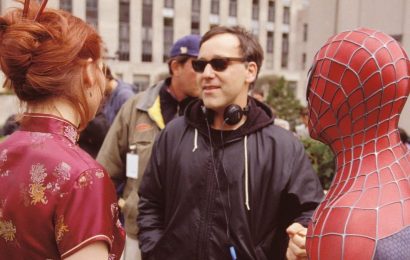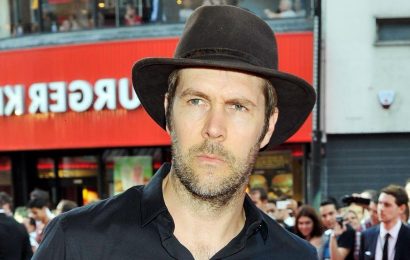Every so often, you’ll see a portrait-of-the-artist documentary that’s so beautifully made, about a figure of such unique fascination, whose art is so perfectly showcased by the documentary format, that when it’s over you can’t believe the film hadn’t existed until now. It feels, in its way, essential. “Nam June Paik: Moon Is the Oldest TV” is like that. Directed by Amanda Kim (it’s her first feature, and so well-done that I expect it to be the first of many), it’s a tantalizing portrait of Nam June Paik, the revolutionary Korean-born video artist who, in the late ’60s and ’70s, did nothing less than invent an art form.
When he was first becoming famous, about 50 years ago, you’d go to see a Nam June Paik installation at someplace like the Museum of Modern Art, and it would seem quirky and exotic — a tower of stacked TV screens, all flashing what looked like the squiggly visual equivalent of feedback. It was weird and kind of gripping, but a part of me would think: What is this doing in a museum? It’s not that it had zero place there. It’s that the notion of “video art” appeared, in its formative days, to be a kind of knowing tech-age contradiction, almost a conceptual conceit, like the art of Marcel Duchamp or the music of John Cage.
In fact, as the documentary shows, Cage, with his visionary avant-garde audience-baiting mock-classical concert stunts, was a god to Nam June Paik. Paik first saw Cage perform in Germany in 1958, a night that changed his life. He came to see his entire existence prior to that as having taken place “B.C.” (before Cage), and the two ultimately became close friends. Paik, born into one of the wealthiest families in Korea, originally planned to be a classical pianist, and the first 20th-century groundbreaker he cleaved to was Arnold Schoenberg, the Austrian-American pioneer of 12-tone music — i.e., the kind of clashing non-harmonic harmony that, for decades, left classical-music audiences occasionally entranced and mostly befuddled. Paik first wanted to play piano and compose like Schoenberg, and once he saw Cage, a world of avant danger opened up to him.
Having fled with his family from Seoul in 1950, during the Korean War, Paik lived and studied in Hong Kong, Tokyo, West Germany, and then Tokyo again. It was there, in 1962, that he acquired a Sony Port-a-Pak, the first commercially available video recorder. That same year he joined the experimental artist collective Fluxus, whose 20 or so members included Yoko Ono, Joseph Beuys, and Jonas Mekas. They saw themselves as a force of revolt, which spoke to Paik. He was in rebellion against his father, whom he hated, and part of what had drawn him to John Cage is that in doing things like wrecking pianos, Cage, in Paik’s view, was overthrowing the primacy — almost the colonialism — of Western music.
Yet part of the fascination of Paik’s story is that even as he moved to New York and signed on to what would become the guerrilla art movements of the late ’60s, he had no clear idea of what he wanted to do. He wanted to attack the status quo — which a lot of people did at the time, producing a lot of really bad didactic “destructive” art. (You could argue that nothing was more bourgeois than their attempt to destroy bourgeois values.) Paik’s version of this was his collaboration with the classical cellist Charlotte Moorman, who at one point performed topless, which got them in trouble for violating decency codes. All very insurrectionary, but on a creative level they were preaching to the avant choir. And Paik, who literally had no money (he’d feed himself on $10 a week that he begged and borrowed), was in America on a travel visa and risked getting kicked out of the country.
It was when Paik fastened onto the TV screen — and, as much as that, the iconography of the TV set — that he began to figure out a way to make his art impulses coalesce. He applied for a grant from the Rockefeller Foundation, and here’s an irony for you: The foundation executive who oversaw arts funding, Howard Klein, had been a music critic for The New York Times, where he had panned a Paik performance. But he immediately grasped the possibilities of Paik’s video vision — and over time became his financial fairy godfather. An early collaboration with WGBH, the public-television station in Boston, was an experiment in turning TV on its head. Paik’s visual noodlings were broadcast a little after prime time, but they proved to be too expensive to produce (the studio time came to $5,000 an hour).
He realized he’d have to figure out a way to do this that was, in his words, as cheap as making a Xerox. He came up with it by collaborating with the Japanese electronics engineer Shuya Abe to invent the Versatile Color TV Synthesizer. It was a revelatory device that allowed you to take a video image and manipulate it in every which way. Armed with this technology, Paik effectively transformed the TV screen into a canvas. “Moon is the Oldest TV” talks a lot about the meaning of his art, and everything that he foresaw, from the Internet to the all-distraction-all-the-time society. But the first thing to say about what Paik did, and why he was a major artist, is that his video art was beautiful. It buzzed and pulsated was a liquid mutating psychedelic splendor. And as we see in one of his typed notes, that was his intent — to work with the freedom and sensuality of Picasso or Pollock. His use of color is as eye-candy bedazzling as Warhol’s, his manipulation of figures on a smeary electromagnetic background a kind of wry commentary on the hypnotic hyper-unreality of television.
In “Moon Is the Oldest TV,” Paik, who died in 2006, emerges as a figure both impish and daunting — the artist as explorer of uncharted terrain, always tweaking and challenging, given to tossing out provocative thoughts (“I use technology in order to hate it properly”), with an almost mystical connection to the arsenal of electronic media he wielded like a plugged-in paintbrush. One of the deep pleasures of “Moon Is the Oldest TV” is that the prophetic quality of Paik’s art is easier to see now, and so it feels more accessible and maybe more joyful. He used his multiple screens, at times hundreds of them, to create the sensation of a society awash at every moment in information. That he found a bold new beauty in that didn’t mean that he wasn’t also on some level questioning this brave new world.
Paik lived modestly in an artists’ co-op on Mercer Street. But it was in 1974, when he unveiled “TV Buddha,” in which a statue of the Buddha watches itself on television, that he began to get famous. Around the same time, his “Global Groove” felt like a hypnotic dream of what would become YouTube. That Paik was Asian, and channeling the mystique of the future, felt groundbreaking in an art world still dominated, in a lopsided way, by Americans and Europeans. And Paik knew how to play to the media. In his slightly broken English, he would toss out his seductive pensées (he coined the term “electronic superhighway”), and he possessed a potent charisma.
The documentary allows us to witness his epic installations, like a giant neon map of the United States that contained a shifting welter of history unfolding on dozens of screens. And we witness his legendary misfire, “Good Morning, Mr. Orwell,” the first international satellite installation, which was broadcast on New Year’s Day of 1984 and meant as a rebuke to George Orwell’s dystopian vision. But it was hosted by a tipsy George Plimpton and proved to be a compendium of live and taped segments that was over-scaled, under-rehearsed, and scattershot (though a couple of the clips we see are sort of mesmerizing).
No matter. Paik’s art had a let’s-try-it-on spirit that made even his follies worthy. He was cosmic but playful, and the opposite of pretentious. That was built into his methodology. After all, he was creating high art…on television! He kept working, reaching to assemble grander visions, and nothing got in the way of his trajectory until he suffered a stroke in 1996, which seriously hobbled him physically. For the next decade, his health declined, yet his 2000 show at the Guggenheim, which we see footage of, was a total wow: a sparkling green zigzag laser from the floor to the top of the atrium, which had the effect of a virtual stairway to heaven. It may be the most moving piece he ever did. Arriving at the end of “Moon Is the Oldest TV,” it lets you know that he’s up there, watching all of us as we watch ourselves on television, thinking with a smile, “I’m still watching.”
Read More About:
Source: Read Full Article







